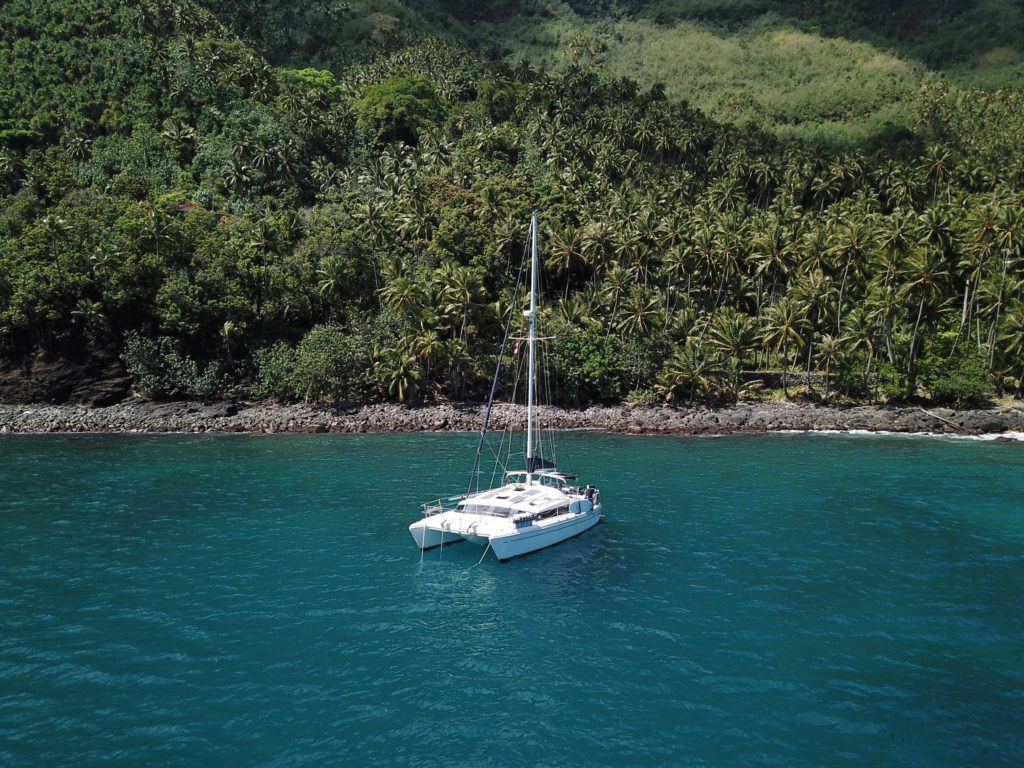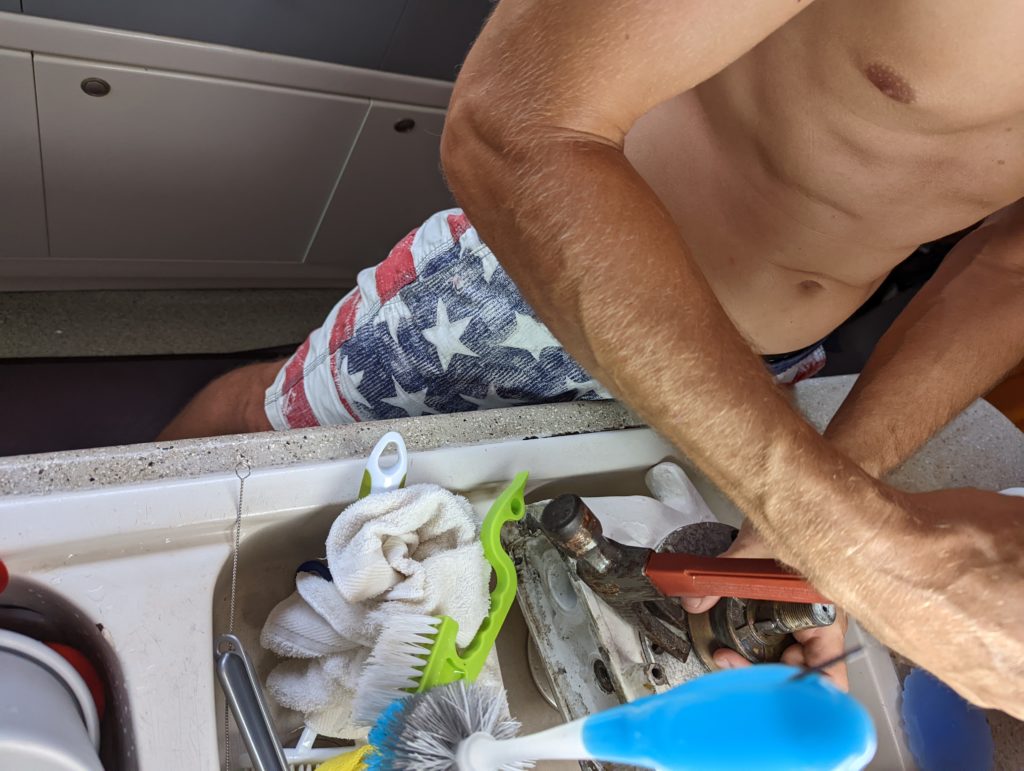We sailed out of Fatu Hiva in the early morning, hoping to arrive in daylight. Winds were light, but we have our spinnaker, so we were able to sail once we got out of the island’s lee. And since we were going west-ish, we had a comfortable ride. We were unusually responsible, for us, and prepared food ahead of time, but even in a calm ride, pouring the Trevor’s hot sauce requires a certain amount of caution.



Tahuata looks very different from Fatu Hiva. Our first sight of land was a rocky peninsula. As we got into the lee of the island, winds got a little squirrely, and we had a couple of sail plan changes and a few minutes of scattered rain, which resulted in this nice rainbow.


We dropped anchor in Hapatoni in the afternoon, and since it was hard to see the sea floor, dove the anchor. We then proceeded to re-anchor two more times: while we’d landed in sand and set just fine (thanks Mantus!), there are a lot of rocks around, wind was blowing onshore (opposite the trades), and we wanted to make sure we wouldn’t snag on anything if the boat took a lazy circle. Re-anchoring was extra annoying because our windlass finally gave up the ghost in between, so Andrew had to haul the chain and anchor up out of thirty feet of water by hand. When we finally got it set, we settled in for a lovely sunset and a well-deserved shower and beer.


Yes, that drone shot is from the next day. We’d read that the pinnacle between this bay and the one to the north, Hanatefau, was a nice place to dive, so we went up to look for coral. And we found it! We also scouted out the bay to the north as a potentiatl other anchoring site, and confirmed that, as the book says, the northern half is sandy, and the south is not.






And before the drone went up, there were dolphins! There’s a pod that likes to hang out in this bay, and they spent the morning swimming around, hunting and playing. They left for a while, then came back in the afternoon.






We got a little bit of a show from the shore side as well, where there was a sporadic waterfall and a parade of goats. Under the boat, we had a pretty constant school of sergents major, who really like to eat Captain’s rejected food scraps.




Beautiful as it is here, we didn’t want to stay forever, so we set to work fixing the windlass. The issue was, as we suspected, that the brushes had gotten stuck (again), and needed to be jiggled. Unfortunately, one of their covers had also gotten stuck, so we had to drill it out. Fortunately, we’d anticpated this and canniballized several spares from our previous windlass motor, so we were able to put the motor back together and get it spinning again. Since we’d cleared out the cabinet, we figured we’d look into why the cockpit button had stopped working. That turned out to be a wire that had snapped at its connection point, a crimp type that has no business being on boats at all, let alone in an outdoor compartment that gets salt spray. We replaced the connections and everything was happy again.




In the same “while we’re here” vein, we took the manual windlass off to give it a much-needed service. It had been sticky when we used it just before the Panama canal, and we’d been meaning to take it apart. When we did, we found several parts that should slide off were refusing to slide. We tried some creative jigging, pictured, but the ticket turned out to be hot soapy water and time. A couple of parts are still getting that treatment as we continue to try to turn the windlass into a pile of gears.





Towards the end of windlass day it got dark and rainy, so we put up the rain-catchers. We’d made bread that morning, so we were well prepared to settle in for a rainy night. We ended up filling two big buckets, which would provide rinse-water for several scuba dives.



When we arrived, both our bay and the adjacent one were empty. But both quickly filled up with boats, including some friends. On Sunday, they invited us to come into town and see the church service, normally not our thing but in this case an excuse to listen to some Marquesan singing. So we made our first forray into shore, where we found a decently protected dinghy dock and some outrigger canoes sporting outboard motors.


The service, held in Marquesan, did feature some excellent singing. We were amused by the flower crown on the virgin Mary, and the creepy-to-American-eyes loop at the bottom of the bell cord.



After the service, a local entrepreneur gave us (the dozen-odd gringos who had showed up) a tour of the marae behind the church, where she picked us some “corossol”, French for soursop. She also rallied the local artisans to show off some excellent wood and bone carvings. We arranged to come by her house/restaurant a few hours later for lunch. Lunch turned out to be tuna prepared three ways, with a special chicken plate for fish-abstaining Jazz.



Our friends on Acushnet told us tales of manta rays swimming under their boat, and they had us over in the evening to see them. We had a great time, but no mantas appeared. So we all resolved to go (back, in their case) to Titikaka, a bay where they had seen lots of mantas, and do a night dive. We fired up the engine and motored the couple of miles north along the beautiful coast. Captain objected immediately when the engine turned on.



As we left the bay, we found the pod of dolphins again! We followed them for a few minutes, and they followed us, playing in our bow wakes. Then they zoomed away to do dolphin things, jumping and spinning in the distance. Amazing experience.









We dropped anchor in clean clear sand in Ivaiva Iti.

Then we swam with the mantas. They were under our boat when we arrived, and we swam around the bay after them when Acushnet arrived a couple of hours later. Sava arrived, and the six of us did a glorious night dive off the back of Acushnet, whose blue underwater lights attracted half a dozen mantas. The next day we caught up on internet, which wasn’t available further south, and had an excellent snorkel around the point to the south of the bay. Then we headed north for Ua Huka.
